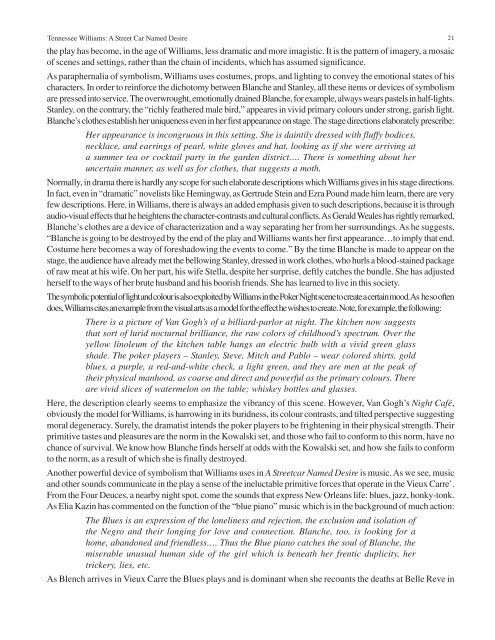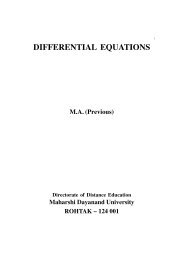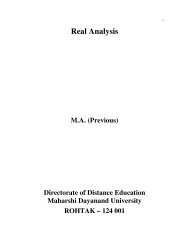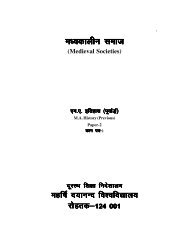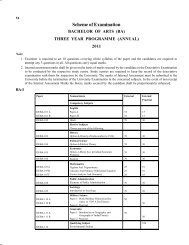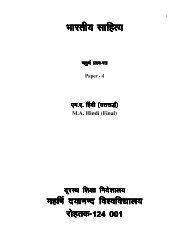LITERATURE AND GENDER - Maharshi Dayanand University, Rohtak
LITERATURE AND GENDER - Maharshi Dayanand University, Rohtak
LITERATURE AND GENDER - Maharshi Dayanand University, Rohtak
You also want an ePaper? Increase the reach of your titles
YUMPU automatically turns print PDFs into web optimized ePapers that Google loves.
Tennessee Williams: A Street Car Named Desirethe play has become, in the age of Williams, less dramatic and more imagistic. It is the pattern of imagery, a mosaicof scenes and settings, rather than the chain of incidents, which has assumed significance.As paraphernalia of symbolism, Williams uses costumes, props, and lighting to convey the emotional states of hischaracters. In order to reinforce the dichotomy between Blanche and Stanley, all these items or devices of symbolismare pressed into service. The overwrought, emotionally drained Blanche, for example, always wears pastels in half-lights.Stanley, on the contrary, the “richly feathered male bird,” appeares in vivid primary colours under strong, garish light.Blanche’s clothes establish her uniqueness even in her first appearance on stage. The stage directions elaborately prescribe:Her appearance is incongruous in this setting. She is daintily dressed with fluffy bodices,necklace, and earrings of pearl, white gloves and hat, looking as if she were arriving ata summer tea or cocktail party in the garden district…. There is something about heruncertain manner, as well as for clothes, that suggests a moth.Normally, in drama there is hardly any scope for such elaborate descriptions which Williams gives in his stage directions.In fact, even in “dramatic” novelists like Hemingway, as Gertrude Stein and Ezra Pound made him learn, there are veryfew descriptions. Here, in Williams, there is always an added emphasis given to such descriptions, because it is throughaudio-visual effects that he heightens the character-contrasts and cultural conflicts. As Gerald Weales has rightly remarked,Blanche’s clothes are a device of characterization and a way separating her from her surroundings. As he suggests,“Blanche is going to be destroyed by the end of the play and Williams wants her first appearance…to imply that end.Costume here becomes a way of foreshadowing the events to come.” By the time Blanche is made to appear on thestage, the audience have already met the bellowing Stanley, dressed in work clothes, who hurls a blood-stained packageof raw meat at his wife. On her part, his wife Stella, despite her surprise, deftly catches the bundle. She has adjustedherself to the ways of her brute husband and his boorish friends. She has learned to live in this society.The symbolic potential of light and colour is also exploited by Williams in the Poker Night scene to create a certain mood. As he so oftendoes, Williams cites an example from the visual arts as a model for the effect he wishes to create. Note, for example, the following:There is a picture of Van Gogh’s of a billiard-parlor at night. The kitchen now suggeststhat sort of lurid nocturnal brilliance, the raw colors of childhood’s spectrum. Over theyellow linoleum of the kitchen table hangs an electric bulb with a vivid green glassshade. The poker players – Stanley, Steve, Mitch and Pablo – wear colored shirts, goldblues, a purple, a red-and-white check, a light green, and they are men at the peak oftheir physical manhood, as coarse and direct and powerful as the primary colours. Thereare vivid slices of watermelon on the table; whiskey bottles and glasses.Here, the description clearly seems to emphasize the vibrancy of this scene. However, Van Gogh’s Night Café,obviously the model for Williams, is harrowing in its buridness, its colour contrasts, and tilted perspective suggestingmoral degeneracy. Surely, the dramatist intends the poker players to be frightening in their physical strength. Theirprimitive tastes and pleasures are the norm in the Kowalski set, and those who fail to conform to this norm, have nochance of survival. We know how Blanche finds herself at odds with the Kowalski set, and how she fails to conformto the norm, as a result of which she is finally destroyed.Another powerful device of symbolism that Williams uses in A Streetcar Named Desire is music. As we see, musicand other sounds communicate in the play a sense of the ineluctable primitive forces that operate in the Vieux Carre’.From the Four Deuces, a nearby night spot, come the sounds that express New Orleans life: blues, jazz, honky-tonk.As Elia Kazin has commented on the function of the “blue piano” music which is in the background of much action:The Blues is an expression of the loneliness and rejection, the exclusion and isolation ofthe Negro and their longing for love and connection. Blanche, too, is looking for ahome, abandoned and friendless…. Thus the Blue piano catches the soul of Blanche, themiserable unusual human side of the girl which is beneath her frentic duplicity, hertrickery, lies, etc.As Blench arrives in Vieux Carre the Blues plays and is dominant when she recounts the deaths at Belle Reve in21


